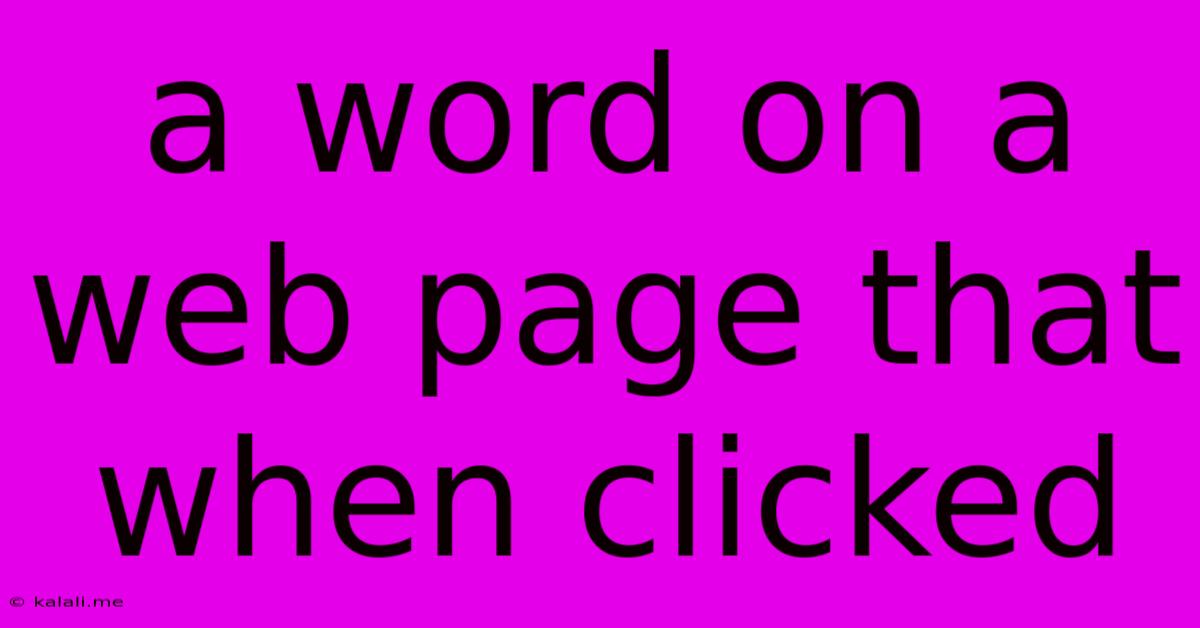A Word On A Web Page That When Clicked
Kalali
Jun 15, 2025 · 3 min read

Table of Contents
A Word on a Web Page That When Clicked: Understanding Hyperlinks and Their Power
Have you ever wondered how a simple word on a webpage can transport you to another website, a different section of the same site, or even trigger an action? That magic is achieved through hyperlinks, also known as links. This article delves into the mechanics of clickable words on web pages, explaining their functionality, different types, and their crucial role in user experience and SEO.
What is a Hyperlink?
A hyperlink, in its simplest form, is a word, phrase, or image that, when clicked, takes the user to a new location – be it another webpage, a file, or even an email address. The clicked element acts as a doorway, bridging the gap between different parts of the internet. The visual cue for a hyperlink is typically underlined text in a different color (often blue), although this can be customized by website designers. The underlying technology involves using HTML code (<a href="#"> This code points the link to the target URL or anchor. </a>). The href` attribute specifies the destination URL or location.
Types of Hyperlinks:
There are several types of hyperlinks, each serving a specific purpose:
-
Internal Links: These links connect different pages within the same website. They are crucial for website navigation and SEO, helping search engines understand the site's structure and improving user experience. They are also beneficial in distributing link juice and ranking power within a site.
-
External Links: These links point to pages on different websites. They are used to provide additional information, cite sources, or direct users to related content on other domains. Using external links demonstrates credibility and can build relationships with other websites.
-
Anchor Links: These links jump to a specific section within the same page. They are useful for long pages with lots of content, allowing users to quickly navigate to relevant sections.
-
Email Links: These links open the user's default email client with a pre-filled "To" address, making it easy to contact the website owner or a specific person.
-
File Links: These links download files, such as PDFs, documents, or images, to the user's computer. These are useful for offering downloadable resources like white papers, ebooks, and other supplementary materials.
The Importance of Hyperlinks:
Hyperlinks are not merely navigational tools; they are essential elements for:
-
Website Navigation: They provide a structured way for users to explore a website, making it easy to find the information they need.
-
SEO: Internal links help search engines crawl and index your website, while both internal and external links improve your site's authority and ranking. Strategic use of anchor text within links is especially crucial for SEO.
-
User Experience: Well-placed, descriptive links improve user engagement and satisfaction by making navigation intuitive and efficient. Clear and relevant anchor text aids in understanding the destination of the link before clicking it.
-
Content Marketing: Hyperlinks are used to expand on topics, cite sources, and build trust and credibility.
-
Content Sharing: They allow users to quickly and easily share pages on social media or other platforms.
In conclusion, that seemingly simple clickable word on a web page—the hyperlink—is a fundamental building block of the internet, playing a vital role in navigation, SEO, and the overall user experience. Understanding its various types and functionalities is crucial for both website developers and content creators aiming to create effective and engaging online content. Mastering hyperlinks will undoubtedly improve your website's performance and user satisfaction.
Latest Posts
Latest Posts
-
List Of Sports Cups And Trophies
Jun 15, 2025
-
Bank Account Closing Letter Word Format
Jun 15, 2025
-
The First Five Multiples Of 9
Jun 15, 2025
-
What Is The Factor Of 112
Jun 15, 2025
-
Difference Between Electron Affinity And Electronegativity
Jun 15, 2025
Related Post
Thank you for visiting our website which covers about A Word On A Web Page That When Clicked . We hope the information provided has been useful to you. Feel free to contact us if you have any questions or need further assistance. See you next time and don't miss to bookmark.